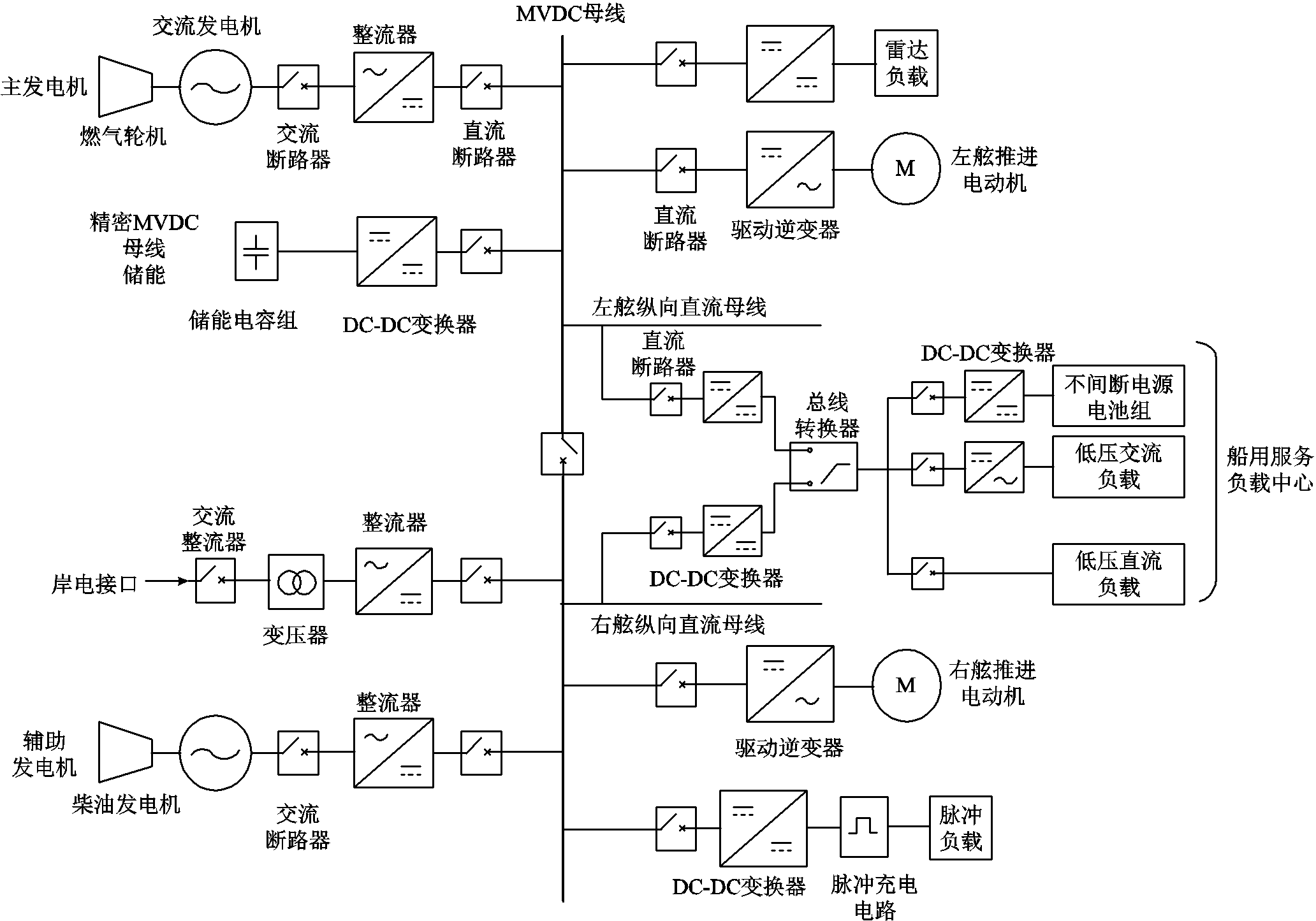
图1 辐射状船舶MVDC IPS(IEEE Std. 1709)
Fig.1 Shipboard MVDC IPS based on radial topology (IEEE Std. 1709)
摘要 船舶中压直流综合电力系统具有高功率密度、高运行灵活性等优势,是我国实施海洋强国战略的重要基础。该论文的第一部分首先分析了船舶电力系统的发展趋势,从拓扑结构、电压等级、接线形式、接地方式等角度梳理了船舶中压直流综合电力系统的特殊系统结构;然后,根据现有文献详细阐述了发电侧整流器、推进变流器、DC-DC变换器等船舶中压直流综合电力系统关键电力电子变换器的研究现状,并进行了详细对比;最后,总结了船舶中压直流综合电力系统与陆上直流微电网的典型差异,并梳理了国内外相关技术标准。
关键词:中压直流 船舶综合电力系统 系统结构 电力电子变换器
传统的船舶由动力系统与电力系统共同构成动力平台。动力系统是指为船舶运动提供动力的系统,一般由常规热机和其他机械设备构成;而电力系统是指为船舶提供电能的系统。这两个系统的设计、制造、使用和管理相对独立[1-2]。船舶综合电力系统(Integrated Power System, IPS)将传统船舶的动力系统和电力系统集成在统一的系统内,以电能的形式给船舶电力推进系统、船载设备和日用设备等供电,从而实现能源的集中控制、综合利用和优化调度,提高了船舶总体设计的灵活性、简化了动力系统结构、降低了船舶噪声能级、提高了效率。船舶综合电力系统是船舶动力系统技术的一次重大变革,具有跨时代的意义[3-6]。
21世纪初,美国海军研究办公室(United States Office of Naval Research, ONR)关注到船舶电气化,并于2002年成立了电动船舶研究联盟(Electric Ship Research and Development Consortium, ESRDC)进行相关探索和技术积累。随着船舶综合电力系统电站容量逐步增加,常规低压供电系统已无法承担电力输送任务,难以满足船上各设备的电力需求,因此电压等级逐步提升。美国海军于2007年10月提出下一代综合电力系统(Next Generation Integrated Power System, NGIPS)概念,并于2009年4月发布NGIPS发展战略[7]。船舶综合电力系统正沿着“中压交流-高频交流-中压直流”的技术轨迹逐步演进。
全球第一代船舶综合电力系统,其显著的特点是中压交流与高频交流相结合,适合吨位较大的船舶,例如,美国海军的“朱姆沃尔特”级导弹驱逐舰和LHD-8两栖攻击舰、英国皇家海军的45型导弹驱逐舰和“伊丽莎白”级航空母舰等。美国和英国等世界海军强国已经实现了第一代中压交流综合电力系统的工程化应用。全球第二代船舶综合电力系统以中压直流供电为标志,不仅适合于大型船舶,而且可覆盖3 000 t级以下全系列船舶,这是船舶综合电力系统的发展趋势,也是我国实施海洋强国战略的重要基础。中压直流供电使原动机转速不受频率的影响,从而突破了发电机的转速限制;取消了大容量的电气变换设备,从而大量减小了系统的体积和质量,优化了船舶总体布局设计,更适合船舶综合电力系统高功率密度、高运行效率、高操作灵活性、高运行可靠性的需求和特点[8]。
2013年3月,ABB公司向多用途船舶(Multi-Purpose Vessel, MPSV)Dina Star交付了首套船载直流电力系统,使其成为世界上第一艘采用现代初级直流电系统的国际海事组织(International Maritime Organization, IMO)船舶[9-10]。目前,国内已经采用船舶二代综合电力系统的网络结构,为一代综合电力系统分系统设备供电,构成了一代半船舶综合电力系统,并进行了系统集成、性能试验和全系统联调试验。文献[11]分析了该系统在建模仿真、不同类型机组并联、系统稳定性和分层协同保护等方面的难点和解决方案。但是,第二代基于中压直流的船舶中压直流综合电力系统(Medium-Voltage DC Integrated Power System, MVDC IPS)的研究仍处于技术攻关的关键阶段。
本论文对船舶MVDC IPS的研究成果进行了梳理和分类,并展开综述,为研究船舶MVDC IPS提供技术支撑。本论文共分为两部分,分别探讨系统结构和电力电子变换器以及故障保护管理技术,本文是论文的第一部分。本文首先阐述了船舶综合电力系统的发展趋势,对船舶MVDC IPS的特殊系统结构(拓扑结构、电压等级、接线形式、接地方式)进行了详细梳理;然后,重点针对船舶MVDC IPS中的特殊电力电子变换器(发电侧整流器、推进变流器、DC-DC变换器)进行了对比和分析;最后,总结了船舶MVDC IPS与陆上直流微电网的典型差异,并梳理了国内外相关技术标准。船舶系统结构和电力电子变换器的暂态特性是电力系统故障分析和继电保护的基础,因此本文也为论文的第二部分——故障保护管理技术奠定了基础。
目前,国内外学者主要提出了三种船舶MVDC IPS拓扑结构:辐射状结构(radial)、环状区域结构(zonal)和环状结构(ring),分别如图1~图3所示。其中,图1和图2分别为IEEE Std. 1709给出的辐射状船舶MVDC IPS、环状区域船舶MVDC IPS的设计标准[12]。

图1 辐射状船舶MVDC IPS(IEEE Std. 1709)
Fig.1 Shipboard MVDC IPS based on radial topology (IEEE Std. 1709)
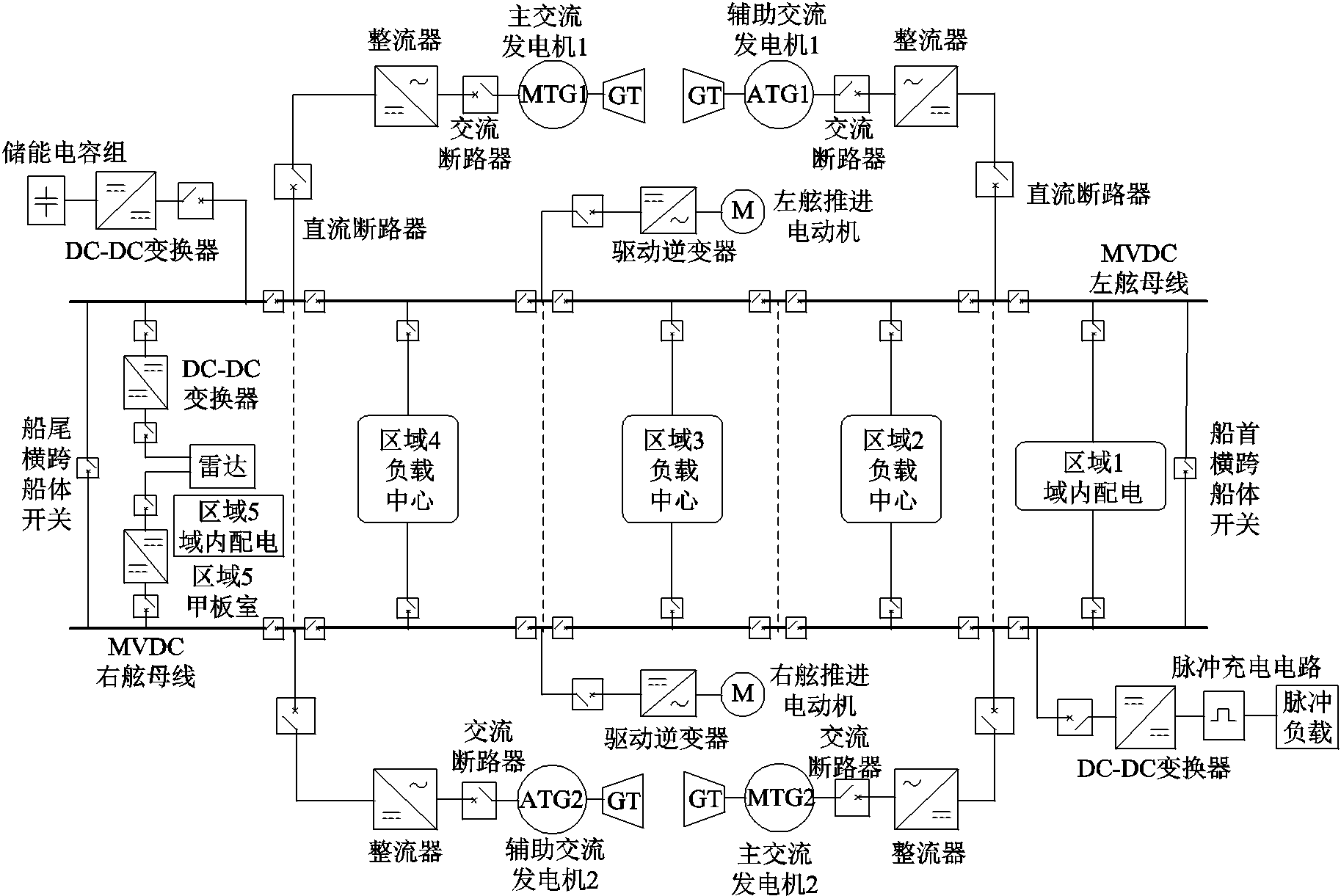
图2 环状区域结构船舶MVDC IPS(IEEE Std. 1709)
Fig.2 Shipboard MVDC IPS based on zonal topology (IEEE Std. 1709)

图3 环状船舶MVDC IPS
Fig.3 Shipboard MVDC IPS based on ring topology
辐射状结构形式简单,在供电可靠性要求不太高且直流大负载相对较少的船舶上,能够最大程度地简化系统设计难度。意大利芬坎蒂尼集团(Fincantieri)的“皇家公主”号(Royal Princess)邮轮采用了辐射状结构船舶MVDC IPS[13-14]。
环状区域结构采用中压直流输电(Medium Voltage DC transmission system, MVDC)和直流区域配电(DC Zonal Electric Distribution System, DC-ZEDS)相结合的方式来提高整个系统的供电可靠性。DC-ZEDS[15-16]可减少配电系统总质量、降低总制造成本,有利于船舶的总体优化和升级改造。与传统的辐射状结构相比,环状区域结构冗余度高、灵活性好,船舶负载可以从左右两舷沿着船舶纵向分布的直流母线获得电力,当一侧发生故障时,船舶重要负载可通过对侧健康的母线继续供电,提高了船舶生命力。高可靠性的环状区域结构也是美国海军舰船电力系统的标准结构[7,17]。
环状区域结构船舶MVDC IPS灵活性最高,拓扑结构最为复杂,不同直流线路、不同节点相互耦合,其故障特性分析和继电保护需要考虑系统中所有节点和线路,保护配置难度高。
环状结构在陆上多端直流电网的相关研究中较为常见[18-21]。在船舶MVDC IPS中,环状结构的灵活性、可重构性和供电可靠性弱于环状区域结构,实际中并不多见。
表1 船舶MVDC IPS不同拓扑结构对比
Tab.1 Comparison of different topologies of the shipboard MVDC IPS
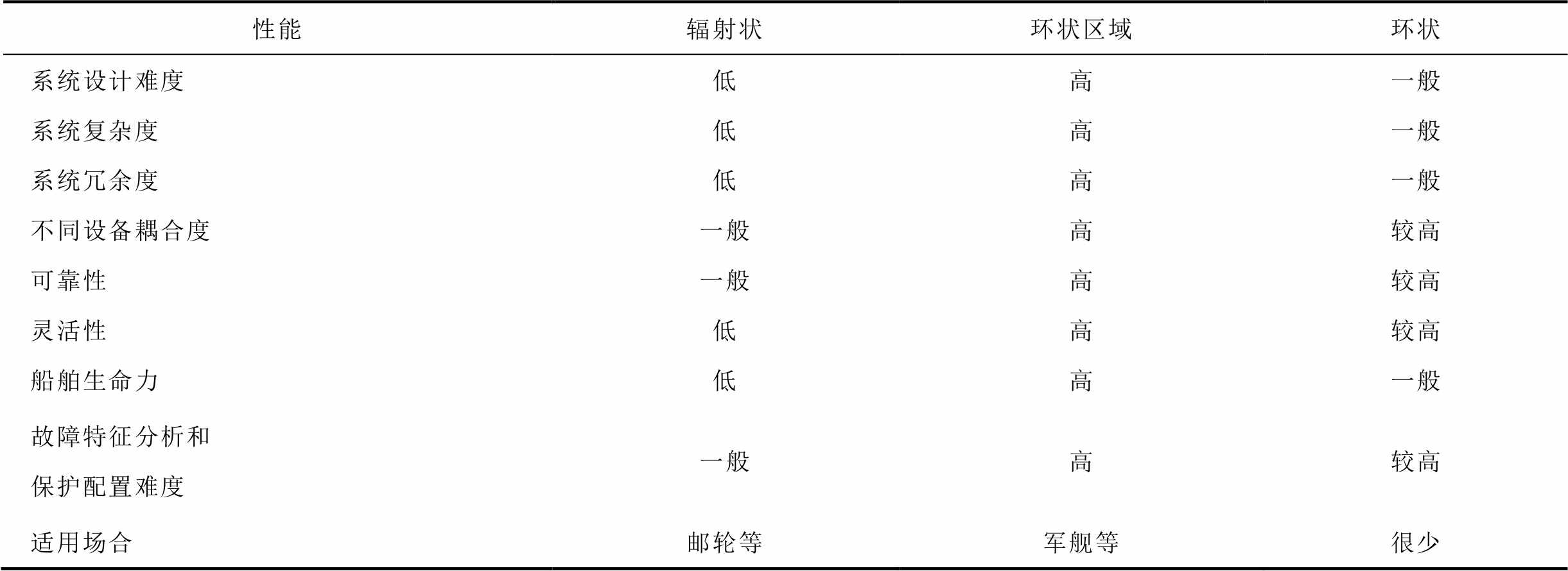
性能辐射状环状区域环状 系统设计难度低高一般 系统复杂度低高一般 系统冗余度低高一般 不同设备耦合度一般高较高 可靠性一般高较高 灵活性低高较高 船舶生命力低高一般 故障特征分析和保护配置难度一般高较高 适用场合邮轮等军舰等很少
注:表中性能对比分为低、一般、较高、高共四个等级。
除上述三种典型拓扑结构外,其他拓扑结构的相关研究并不多见。在国外,主要是美国得克萨斯大学奥斯汀分校的S. Santoso教授课题组在文献[22-25]中有相关研究。
文献[22]提出两种一个半断路器(Breaker-and-a-Half, BAAH)拓扑结构:BAAH-v1结构和基本BAAH结构。与环状区域结构相比,BAAH-v1结构提高了脉冲负载和储能系统可靠性,但区域负载中心和雷达系统可靠性不高。文献[23]对比发现,基本BAAH结构的系统整体中断率比环状区域结构低17.8%,比双母线双断路器(Double Bus Double Breaker, DBDB)结构低40.0%。基本BAAH结构最多同时承受3次最坏情况攻击,环状区域结构为8次,DBDB结构为4次[24]。基本BAAH结构比环状区域结构增加了9个直流断路器,受限于船舶空间和成本,该拓扑实用性不高。文献[24]改进了基本BAAH结构,新结构最多同时承受最坏情况攻击数提高到8次。文献[25]设计了一种菱形结构和一种六边形结构船舶MVDC IPS拓扑,每种拓扑最多同时承受14次最坏情况攻击,但上述两种新型拓扑仅从拓扑学和规划角度进行设计,没有充分考虑船舶的物理空间和布线。
综上所述,与文献[22-25]中其他新型拓扑结构相比,环状区域结构的可靠性、灵活性、弹性、实用性最为平衡,是目前工程落地前景最好的一类拓扑结构。
目前,船舶MVDC IPS直流电压为1 kV以上,系统功率为20~100 MW[26]。IEEE推荐的船舶MVDC IPS的电压等级见表2,为1.5、3、6、12、18、24和30 kV[12]。随着船舶电站容量的提升,受限于直流断路器的电流开断能力和投资成本,船舶MVDC IPS的电压等级也将逐步提升。文献[27]认为,我国未来船舶综合电力系统中压侧直流电压等级将达到8~15 kV,低压侧直流电压等级将达到700~1 000 V。
表2 船舶MVDC IPS电压等级(IEEE Std. 1709)
Tab.2 Shipboard MVDC IPS voltage classes (IEEE Std. 1709)

MVDC等级/kV标称额定电压等级/kV最大额定电压等级/kV 目前已有等级1.51.5或±0.752或±1 33或±1.55或±2.5 66或±310或±5 1212或±616或±8 1818或±922或±11 未来设计等级2424或±1228或±14 3030或±1534或±17
目前直流输配电网的接线方式主要有三种,分别为单极不对称接线方式、单极对称接线方式(伪双极)和双极接线方式(真双极),如图4所示。
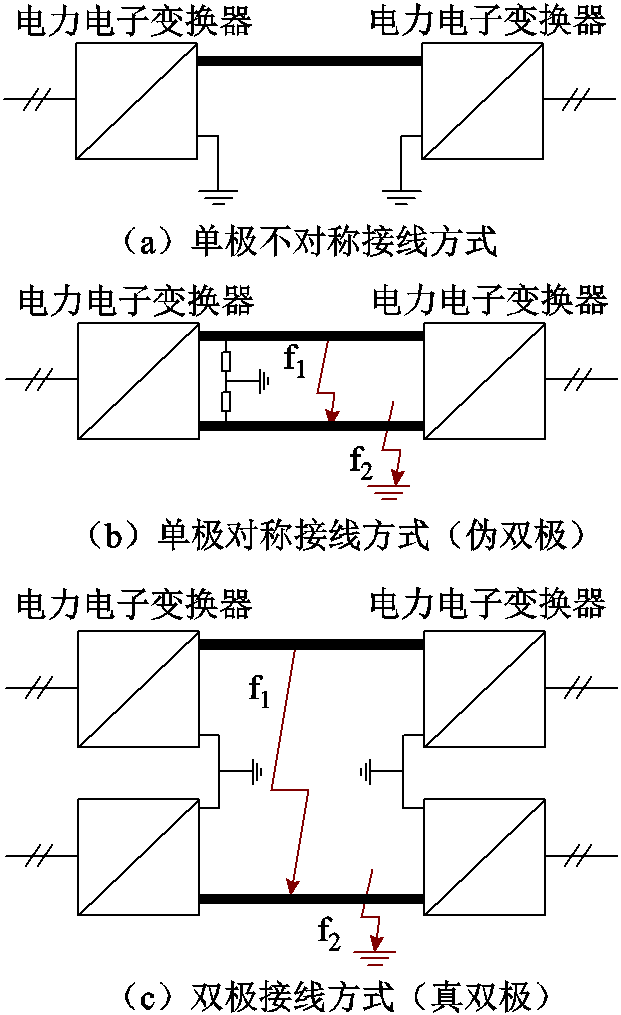
图4 系统的接线形式
Fig.4 Wire connection types of the shipboard MVDC IPS
1)三种接线方式中,单极不对称接线方式并不多见,其直流线路对地绝缘水平要求高,大多作为工程发展初期的过渡形式。目前已投运的基于两电平或者三电平电压源型换流器(Voltage Source Converter, VSC)的柔性直流输电工程大都由ABB公司设计和制造,其直流侧接线形式一般采用伪双极形式[28-29]。虽然单极对称接线方式与单极不对称接线方式仅接地点位置有所不同,但其直流设备绝缘投资更低。
2)采用单极对称接线方式的系统,只要有一极直流线路发生故障,整个双极系统会全部失去。
3)采用双极接线方式的系统,一极直流线路发生故障后另一极仍能继续运行,其系统灵活性和可靠性更高。但每一端都需要分别建设正、负极换流器,工程造价更高。
因此,若考虑造价成本,单极对称接线方式适合大多数船舶MVDC IPS的场景;对于高供电可靠性的大型特殊船舶,双极接线方式的系统更加适合[26,30-31]。
如图4b和图4c所示,船舶MVDC IPS的直流输电线路故障主要包括双极短路故障f1和单极接地故障f2。双极短路故障多为极间金属性接地故障,是直流系统中危害最为严重的故障类型,也是船舶直流线路保护配置中需重点考虑的故障类型。
船舶MVDC IPS接地方式的选择会对单极接地故障条件下的过电压和过电流产生重要影响,进而影响故障特征和继电保护算法设计。
总体上,国内外专家学者将直流系统接地方式分为电源中性点不接地、用电设备外壳直接接地(IT),电源中性点直接接地、用电设备外壳也直接接地(TT)和电源中性点直接接地、设备外壳等可导电部分与电源中性点有直接电气连接(TN)三种[32]。TT系统供电连续性优于TN系统,TN系统比TT系统更经济,IT系统安全性高但一次接地故障检测比较困难。目前陆上直流微电网一般推荐采用TN系统,船舶电力系统一般采用IT系统[33]。
具体而言,船舶MVDC IPS的接地方式如图5所示,可分为交流电源侧接地方式和直流侧接地方式。其中,直流侧接地方式又分为负载端直流侧接地方式和电源端直流侧接地方式。

图5 船舶MVDC IPS的接地方式
Fig.5 Grounding modes of the shipboard MVDC IPS
交流电源侧接地方式主要有直接接地、经电阻接地和不接地三种形式。对于交流电源侧:如果船舶电力系统中性点不接地,高盐高湿的复杂海洋环境会加剧对地电弧并可能进一步引起系统电压失稳[34]。因此,文献[34]建议船舶电力系统采用高阻接地方式,以减弱此风险。文献[35]认为舰载电力系统的最佳接地方式是高阻接地方式,高阻接地系统可以消除潜在瞬态过电压、减小线路对地短路故障电流。根据IEEE Std.1662—2016,为降低故障后短路电流,电压等级超过1 kV、系统功率超过1.5 MW的船舶电源侧宜采用高阻接地方式[36-37]。无论是国内还是国外,低压船舶电力系统一般采用中性点不接地方式,中压船舶电力系统一般采用中性点高阻接地方式[35,38]。
船舶MVDC IPS负载端直流侧接地方式与陆上直流输配电系统的直流侧接地方式相同,主要取决于交直流电力电子变换器选择两电平/三电平VSC还是模块化多电平换流器(Modular Multilevel Converter, MMC)。对于两电平/三电平VSC,主要分为电容中点接地和电容中点经电阻接地两种接地方式;对于MMC,主要分为不接地、钳位电阻接地、电容中点经电阻接地三种接地方式[39-43]。文献[44]分析比较了VSC不同接地方式的优缺点,结果表明VSC电容中点高阻接地方式优于直接接地方式,高阻接地方式更有利于直流配电系统故障消除后的快速恢复。文献[45]的仿真结果表明,直流侧MMC经钳位电阻接地或不接地、VSC经电阻接地可加快故障恢复速度。
船舶中压综合电力系统发电侧的柴油机或燃气轮机一般采用基于二极管的三相桥式不可控整流器进行换流[46-48]。如图6所示,船舶MVDC IPS的电源端三相桥式不可控整流器直流侧接地方式主要有四种:不接地、直接接地、直接电阻接地和钳位电阻接地。

图6 电源端直流侧接地方式
Fig.6 Grounding modes of the DC side near the generators
不接地方式在过电压控制能力方面不足。直接接地方式可以将过电压控制在合理水平,但如果发生单极接地故障,会在该极形成对地短路,短路电流较大。钳位电阻接地方式在故障电流控制和供电连续性方面有优势,但正常运行过程中会产生额外的有功损耗,接地电阻的热量可能会导致老化等问题。直接电阻接地方式兼有不接地和直接接地方式的优点,目前看是一种较为合适的电源端直流侧接地方式。仿真结果表明,如果船舶MVDC IPS采用直接电阻接地方式,当接地电阻为400~800 Ω时,过电压和过电流均可以被平衡在合理范围内,故障电流可以被有效限制,能够避免故障后系统中断[49-50]。
深度电力电子化是船舶MVDC IPS最主要的特性之一[51]。电力系统故障发生后,不同类型电力电子变换器具有不同的暂态响应特性,对电力系统故障分析和保护配置具有较大影响。
船舶MVDC IPS中的关键电力电子变换器主要包括连接船舶柴油机或燃气轮机的发电侧整流器,连接船舶电力推进系统的推进变流器(逆变器),连接直流负载、储能或者直流区域配电(DC-ZEDS)的DC-DC变换器(直流变压器)。
发电侧整流器将船舶柴油机或燃气轮机发出的交流电转换为直流电,经中压直流输电网络为负载供电。常见的发电侧整流器有二极管整流器、基于晶闸管的电流源型换流器、两电平/三电平VSC、MMC等[52]。
5.1.1 二极管整流器
二极管整流器结构简单、成本低廉,仅支持单向导通,属于不可控整流器。配置二极管整流器的船舶MVDC IPS发电模块(Power Generation Modules, PGM)的调压主要是通过调节同步发电机组的励磁系统来实现。实际工程中,根据系统的电压、功率、电能质量要求,往往采用多相多脉波整流器(如两个6脉波二极管三相桥式整流器可串联构成12脉波整流器)作为交直流变换的接口,以降低谐波和改变电压等级。为提高船舶发电侧二极管整流器的故障限流能力和电压控制能力,文献[53-54]提出在二极管整流器直流侧级联DC-DC变换器构成船舶发电侧复合式AC-DC变换器。
在船舶中压综合电力系统发电侧,柴油机或燃气轮机一般采用基于二极管的三相桥式不可控整流器进行换流。12脉波整流器具有电路结构简单、成本低、可靠性高、滤波简单的特点,在船舶发电侧电能变换中得到了广泛应用。参考实际高压直流输电工程和混合直流输电工程,为滤除12脉波换流器直流侧的特征谐波,可配置12/24双调谐直流滤波器或者12/24/36三调谐直流滤波器[55-56]。根据船舶空间和实际需求,可配置12单调谐直流滤波器或者12/24双调谐直流滤波器。
5.1.2 基于晶闸管的电流源型换流器
基于晶闸管的电流源型换流器技术成熟、可靠性高、成本相对较低,且可以通过改变导通角控制电压。基于晶闸管的电流源型换流器广泛应用于国内传统基于电网换相换流器(Line Commutated Converter, LCC)的高压直流输电工程中。直流线路故障后,传统高压直流输电工程通过晶闸管换流器的低压限流(Voltage Dependent Current Order Limiter, VDCOL)控制和线路平波电抗器可以把故障电流限制在0.45(pu)~0.55(pu)[57]。相似地,文献[58]通过控制发电侧晶闸管整流器的触发角,也可以在船舶中压综合电力系统中实现故障限流,从而避免了使用昂贵的直流断路器。但是,使用晶闸管整流器会不可避免地带来无功补偿问题,因此在实际船舶中反而增加了无功补偿装置。
5.1.3 两电平/三电平VSC
基于IGBT等全控型器件的两电平/三电平VSC运行方式灵活,可独立调节有功功率和无功功率,具备四象限运行能力。与二极管整流器、晶闸管换流器相比,其成本更高,控制更加复杂。此外,直流侧故障后,两电平/三电平VSC直流侧并联的大电容迅速放电,进一步提高了故障暂态电流。
5.1.4 MMC
MMC可以实现对直流电压、功率的灵活控制,在高压直流输电领域应用越加广泛[59]。与两电平/三电平VSC不同,MMC整流器直流侧谐波少,没有配置高压电容器组,避免了直流侧故障后大电容的放电过程。考虑到船舶MVDC IPS的电压等级,两电平/三电平VSC既可以满足相应电压要求,并不需要串联多个子模块的MMC。同时,MMC控制策略复杂,成本更高,其众多子模块也增加了船上占地空间和设备质量[58,60-61]。
5.1.5 对比分析
不同船舶MVDC IPS发电侧整流器的性能对比见表3。二极管整流器成本低、结构简单、无需复杂控制、可靠性高、技术成熟、功率损耗低、占用空间不大,综合来看,其在船舶MVDC IPS发电侧整流环节中的优势较为明显[46-48]。
表3 船舶MVDC IPS发电侧整流器对比
Tab.3 Comparison of rectifiers in shipboard MVDC IPS

性能二极管整流器基于晶闸管的电流源型换流器两电平/三电平VSCMMC 成本低一般较高高 系统结构简单一般较复杂复杂 控制策略无简单一般复杂 系统灵活度一般一般高高 可靠性高较高一般一般 技术成熟度高高较高一般 故障暂态电流较高一般高较高 开关数量少少一般多 开关和功率损耗低一般一般高 占地空间一般大一般大
船舶中压IPS中约80%的电站容量用于电力推进,电力推进系统是IPS最关键的负荷。电力推进系统与直流输电网络连接的推进变流器主要有基于晶闸管的电流源型逆变器、两电平VSC、MMC和其他多电平逆变器。
5.2.1 基于晶闸管的电流源型逆变器
电流源型逆变器在船舶交流电力推进系统中研究较早,其技术成熟度高。大多数商船配置的都是周波变换器(cycloconverter)和负载换相式逆变器(Load Commutated Inverter, LCI),其中,LCI在大型船舶交流电力推进系统中应用十分广泛[62]。配置同步电动机的LCI普遍应用在大型豪华邮轮的推进系统中,如应用在嘉年华邮轮公司、水晶邮轮公司和丘纳德邮轮公司的一些邮轮等,但是难以直接应用到船舶MVDC IPS,应用时需要进行改进或重新设计[13,50,63]。
5.2.2 两电平VSC
电流源型逆变器技术成熟度高,但两电平VSC和MMC性能更好,近年来应用越来越广泛。两电平VSC结构简单,且成本低于MMC,已经成为未来陆上直流配电网/直流微电网的首选换流器。目前越来越多的船舶电力推进系统逆变器选用两电平VSC[64-66]。
5.2.3 模块化多电平换流器(MMC)
MMC电压可扩展性强,控制灵活性更高,输出性能更好,国内外学者认为MMC也可以作为船舶MVDC IPS的推进变流器,并进行了相关探索[67-69]。但是,船舶推进电机主要是高转矩、低速的电动机,MMC子模块电容器的电压波动幅度与输出频率成反比,在低速时(尤其是高转矩负载),电容电压波动急剧增大,阻碍了其在高性能电机驱动场景中的应用[70-72]。
5.2.4 其他多电平逆变器
多电平逆变器技术是在两电平技术的基础上发展而来的,除MMC外,典型的中压逆变器还有二极管钳位型(Neutral Point Clamped, NPC)和H桥级联(Cascaded H-Bridge, CHB)多电平逆变器等。Ansalda、ABB、Siemens、GE等企业都有基于NPC和CHB的船舶中压大功率变流器产品。一般而言,在6 kV以下的系统中主要采用的拓扑结构为二极管钳位型三电平变流器拓扑(3-Level NPC, 3L-NPC),如ABB的PCS6000系列产品(功率32 MW)、ACS6000系列产品(功率27 MW)。为提升多电平逆变电路的变换性能,ABB也推出了5L-NPC产品(ACS5000系列等)。6 kV以上系统可以采用CHB或者NPC+CHB的混合拓扑[73-75]。
CHB需要多个独立直流电源供电,主要用于船舶交流IPS,通常通过交流侧的多绕组移相变压器实现,无法在船舶MVDC IPS中应用。NPC可以用于船舶MVDC IPS,但仍存在母线中点电压平衡的问题,目前还没有成熟的可直接应用于船舶MVDC IPS的产品[76]。此外,采用器件串联技术的多电平逆变器,其系统可靠性低于LCI和两电平VSC。
5.2.5 对比分析
不同推进变流器的技术性能对比见表4。
表4 船舶MVDC IPS推进变流器对比
Tab.4 Comparison of inverters in shipboard MVDC IPS

性能基于晶闸管的电流源型逆变器(LCI)两电平VSCMMC其他多电平逆变器 成本一般较高高高 系统结构一般较复杂复杂复杂 控制策略简单一般复杂复杂 系统灵活度一般高高高 可靠性较高高一般一般 开关数量少一般多多 开关和功率损耗一般一般高高 低速高转矩工况适用适用不适用适用 技术成熟度一般高低一般
MMC性能较好,但在船舶低速高转矩工况下存在电容电压低频波动问题;LCI和两电平VSC的系统结构、控制复杂度、开关和功率损耗、可靠性都优于多电平逆变器;LCI采用晶闸管器件,成本低,但难以直接应用于船舶MVDC IPS。相比而言,两电平VSC技术更加成熟。
根据是否具备电气隔离特性,双向DC-DC变换器可分为隔离型双向DC-DC变换器和非隔离型双向DC-DC变换器。非隔离型双向DC-DC变换器两侧容易产生干扰,高可靠性的隔离型双向DC-DC变换器在实际工程中应用更广泛[77-79]。
隔离型双向DC-DC变换器的各种常用拓扑主要是推挽电路、反激电路、半桥/全桥电路的改进和组合,但大都对支撑电容的要求较高,限制了其在高电压、大功率场合的应用。隔离型双有源全桥(Dual Active Bridge, DAB)拓扑具有电气隔离、能量双向流动、功率密度高、开关损耗低、易于实现软开关等特点,在直流配电网、储能、电动汽车等领域的得到了广泛应用[80-82],其拓扑结构如图7所示[83]。针对高电压等级和大功率的船舶MVDC IPS应用场景,DAB拓扑更为合适。

图7 DAB变换器拓扑[83]
Fig.7 Topology of the DAB converter[83]
同时,传统DAB变换器单个支路能够承受的电压等级较低,适用于中压直流的DAB变换器尚无实际工程应用,相关样机处于研发阶段[30]。为满足实际船舶MVDC IPS的电压与容量要求并降低功率半导体器件的电压电流应力,目前主要有三种典型结构的DC-DC变换器:①多电平结构DC-DC变换器;②基于SiC器件的DC-DC变换器;③模块化组合式DC-DC变换器。这三种结构大都借鉴了DAB拓扑的思路。
5.3.1 多电平结构DC-DC变换器
多电平结构DC-DC变换器功率密度高于两电平变换器,成本可控。多电平结构DC-DC变换器中,三电平变换器的电路结构和控制算法的复杂性较低,因此最为常用。三电平变换器的开关管的电压应力是输入电压的一半,文献[84]将三电平变换器的推导思路推广到所有的直流变换器,提出三电平变换器族系。文献[85]提出一种基于粒子群优化(Particle Swarm Optimization, PSO)算法的3L-NPC-DAB变换器最小电流应力方案,但3L-NPC-DAB存在输入直流母线电容器的电压不平衡问题。文献[86]提出了一种5L-NPC-DAB变换器拓扑结构,将传统两电平DAB变换器的输入直流电压提高了4倍。
5.3.2 基于SiC器件的DC-DC变换器
SiC电力电子器件的优势在于具有高电压(几十kV)、高温(>500℃)特性,突破了硅基功率半导体器件电压(数kV)和温度(<150℃)限制[87]。SiC器件在海洋DC-DC变换器领域的应用研究已经逐步开始[88]。文献[89]提出一种基于SiC的五级混合有源NPC(Five-Level Hybrid Active NPC, FL-HANPC)DAB变换器。基于15 kV SiC MOSFET器件,文献[90]提出一种适用于中压直流领域的隔离性DAB变换器拓扑结构。目前商业化的SiC器件主要集中在0.9~3.3 kV,并出现部分5.5 kV的产品。受限于衬底质量、外延生长工艺和器件终端设计水平,适用于高压大电流场景下(10 kV及以上)的SiC器件仍处于技术储备阶段,离实际应用仍有一定距离[91]。
5.3.3 模块化组合式DC-DC变换器
利用DC-DC变换器模块化组合的方式,DC-DC变换器的电压等级在理论上可以一直提升,从根本上降低每个功率半导体器件上的电压应力。同时,模块化组合式DC-DC变换器往往需要大量开关器件、电感器、变压器和电容器等,因此变换器体积较大、控制系统复杂度较高。
文献[92]比较了串联谐振变换器(Series Resonant Converter, SRC)、双向半桥(Dual Half Bridge, DHB)和DAB三种拓扑分别作为直流电网中模块化DC-DC变换器的子模块的适用性。从复杂度、功率限制和成本三个角度综合来看,DAB拓扑最为适合。文献[27]利用模块化思路和双有源桥技术,提出一种船舶MVDC IPS三端口直流变压器。一般而言,模块化组合式DC-DC变换器主要包括基于输入串联输出并联(Input-Series Output-Parallel, ISOP)结构的DAB变换器和基于MMC结构的DC-DC变换器[93]。
1)ISOP结构的DAB变换器
ISOP-DAB变换器各模块之间的功率均衡是正常运行的基本前提,否则模块过电压可能造成器件损毁和系统失稳。由于ISOP-DAB变换器各模块之间的输入电流、输出电压恒相等,因此,解决功率均衡问题就是解决输入均压(Input Voltage Sharing, IVS)、输出均流(Output Current Sharing, OCS)问题。基于自然功率均衡法的均压、均流方法简单易实现,各模块间控制系统无耦合,模块化程度和系统可靠性较高,但均压、均流效果和输出电压调节率性能一般[94-97]。基于输入均压或输出均流控制器的均压、均流方法性能更好,但各模块控制系统相互耦合,模块化程度与可靠性一般[98-99]。此外,ISOP-DAB变换器的每个功率单元都需要一个笨重且昂贵的中频变压器,成本较高。
2)MMC结构的DC-DC变换器
MMC-双向DC-DC变换器具有一定的故障容错运行能力,可提高直流电网的供电可靠性,文献[100]分析和比较了MMC-双向DC-DC变换器的几种基本的输入串联拓扑特性。文献[101]提出一种两相模块化多电平结构的直流变压器拓扑。针对船舶MVDC IPS,文献[93]提出一种优化船舶MMC-DC-DC变换器中各组件电压应力的总体控制策略。通过一个中频变压器连接两个MMC,文献[102]研究了一种直流电网隔离式模块化多电平DC-DC变换器(isolated Modular Multilevel DC-DC Converter, iM2DC)的拓扑结构,以及其子模块能量平衡机制、仿真和实验结果等。基于文献[102],文献[103]提出一种基于iM2DC的带直流有源滤波器功能的船舶MVDC IPS混合式储能系统。文献[104]提出一种船舶MVDC IPS模块化多电平DAB(Modular Multilevel DAB, M2DAB),此变换器同时具备故障限流、故障保护和故障穿越能力。将MMC技术和DAB技术相结合,文献[105-106]分别提出了适用于中压直流电力系统的模块化组合式DC-DC变换器。
5.3.4 对比分析
不同船舶MVDC IPS DC-DC变换器的技术性能对比见表5。基于SiC器件的中高压DC-DC变换器技术成熟度低,尚未商业化;三/五电平结构DC-DC变换器结构简单、成本低,功率密度高于模块化组合式DC-DC变换器,但存在电容电压均衡问题;模块化组合式DC-DC变换器可扩展性强且具有一定容错运行能力。文献[107]比较了ISOP DAB和iM2DC在船舶MVDC IPS中的稳态性能和故障运行性能。结果表明,ISOP DAB功率密度较好,且具备故障电流控制能力,iM2DC具有较好的故障运行性能,两者都是船舶MVDC IPS中DC-DC变换器的可行拓扑。
表5 船舶MVDC IPS DC-DC变换器对比
Tab.5 Comparison of DC-DC converters in shipboard MVDC IPS
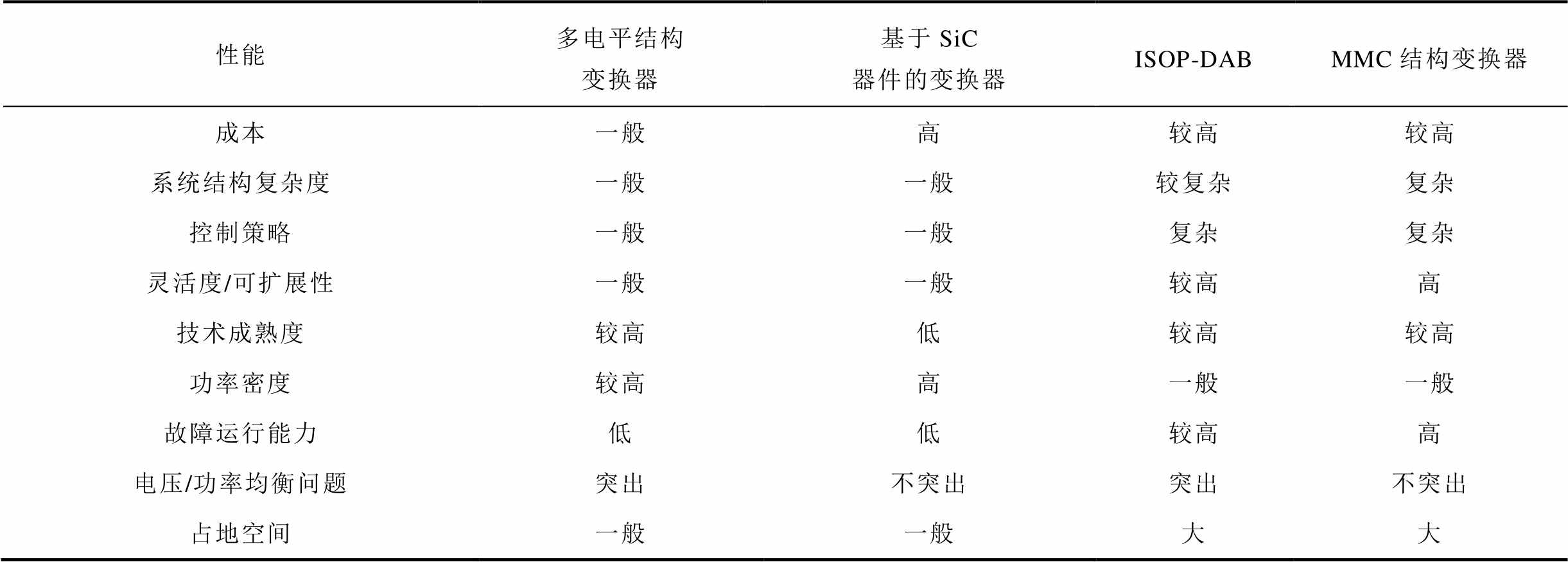
性能多电平结构变换器基于SiC器件的变换器ISOP-DABMMC结构变换器 成本一般高较高较高 系统结构复杂度一般一般较复杂复杂 控制策略一般一般复杂复杂 灵活度/可扩展性一般一般较高高 技术成熟度较高低较高较高 功率密度较高高一般一般 故障运行能力低低较高高 电压/功率均衡问题突出不突出突出不突出 占地空间一般一般大大
船舶MVDC IPS与船舶交流IPS差异明显,本文不再赘述。虽然陆上直流微电网和船舶MVDC IPS都是独立的直流微电网,但是船舶MVDC IPS有其特殊性。
1)从拓扑结构看,陆上直流微电网的主要拓扑是辐射状结构和环状结构;邮轮等客渡船的船舶MVDC IPS可以采用简单的辐射状结构,但对可靠性、海上生存能力要求高的军舰等大型船舶,首选环状区域结构。
2)从设备尺寸看,陆上直流微电网对电力设备体积、质量要求不高;而船上空间有限,船舶对电力设备体积、质量要求严格。
3)从供电可靠性看,系统故障后陆上直流微电网可以暂时将负载转移到大电网;只有在岸边停泊时候,船舶才接入陆上岸电系统。为保证人员安全和电推系统运行,船舶电推系统在航行过程中不能停运,对供电连续性、可靠性要求更高。特殊地,船舶电推系统会采用容错控制,保证故障情况下电推系统继续运行。
4)从电源结构看,陆上直流微电网一般连接大量分布式可再生能源,新能源发电具有随机性和波动性;船舶一般只配置柴油机或燃气轮机,风电、光伏等新能源电源较少,电源出力确定性高。
5)从负载特性看,陆上直流微电网的负荷连续、规律性强、瞬时波动不大;船舶MVDC IPS中约80%的电站容量用于电力推进,电推系统是综合电力系统最关键的负荷。船舶电力推进系统的功率取决于系统模式、实时海况、天气条件等,可预测性不强。复杂海况或者军舰战斗过程下螺旋桨可能频繁进出海面,导致螺旋桨负载瞬时变化,造成推进电机和轴系转矩、功率剧烈波动。特殊工况下,船舶MVDC IPS中的特殊脉冲负荷也加剧了负荷预测的难度和系统负载功率波动。与陆上直流微电网不同,船舶中压直流综合电力系统负载的优先级是根据船舶的任务来确定的,因此不同工况下,船舶同一负荷的重要度等级和供电优先级并不相同。
6)从输电线路看,陆上直流微电网的输配电线路长度比直流输电线路短,线路阻尼小;船舶MVDC IPS不同电力设备间布局更为紧凑,输配电线路更短,各设备耦合紧密,容易互相影响。
7)从系统运行模式看,陆上直流微电网的系统运行模式较多,大多可预测且相对确定;为保证船舶故障情况下继续航行和重要负荷持续工作,船舶继电保护装置和断路器动作后,系统将进行故障后重构。为应对多种故障类型,船舶MVDC IPS系统运行模式复杂多变。
8)从接地方式看,陆上直流微电网一般采用TN系统,船舶电力系统一般采用IT系统。
船舶MVDC IPS与船舶交流IPS外、陆上直流微电网有诸多差异,国内外针对性地制定了相关技术标准。
6.2.1 IEEE标准
21世纪初,除美国ONR,IEEE同时也关注到了船舶电气化趋势。IEEE的DC Power Systems on Ships(IAS/PCI/1709_WG)工作组于2010年发布了IEEE Std. 1709—2010 IEEE Recommended Practice for 1 kV to 35 kV Medium-Voltage DC Power Systems on Ships,并于2018年发布了更新版本IEEE Std. 1709—2018。这是全球最早的、影响范围最广的船舶MVDC IPS的国际标准[12]。
新型电力系统具有“双高”和“双随机”的特点,核心特征之一为高比例电力电子设备的应用,船舶MVDC IPS的电力电子化特征也越加明显。对于船舶MVDC IPS内的电力电子器件,暂无相关特定技术标准,可参考IEEE Std. 1662—2008 IEEE Guide for the Design and Application of Power Electronics in Electrical Power Systems on Ships及其更新版本IEEE Std. 1662—2016 IEEE Recommended Practice for the Design and Application of Power Electronics in Electrical Power Systems[36-37]。
采用MVDC IPS的船舶,其停泊后接入港口岸电系统的标准,可参考IEC/IEEE International Standard 80005-1:2019 Utility Connections in Port-Part 1: High Voltage Shore Connection (HVSC) Systems-General Requirements[108]。船舶MVDC IPS的直流区域配电侧的接口标准,可参考IEEE Std. 1826—2020 IEEE Standard for Power Electronics Open System Interfaces in Zonal Electrical Distribution Systems Rated Above 100 kW[109]。
6.2.2 国内标准
国家标准方面,在2014版的基础上,2017年12月,中国船舶重工集团公司第七〇四研究所、青岛海检集团有限公司发布了新版《船舶中压直流电力系统通用要求》(GB/T 35719—2017)和《船舶直流电力系统短路电流计算方法》(GB/T 35715—2017)[110-111]。行业标准方面,2023年3月,中国船级社(China Classification Society, CCS)在《直流配电电力推进系统检验指南》(2020年版)的基础上,发布了《船舶直流综合电力系统检验指南》(2023年版),该标准于2023年5月1日生效。
船舶综合电力系统正朝着大容量、高功率密度、智能化方向发展,第二代基于中压直流的船舶MVDC IPS凭借优良的技术性能吸引了国内外研究者的广泛关注。
本文是本论文的第一部分。
首先,本文梳理了船舶MVDC IPS的系统结构的研究现状,对比和总结了不同技术路线的优劣。
1)随着船舶电站容量的提升,未来船舶MVDC IPS电压等级可达24 kV和30 kV。
2)辐射状拓扑结构形式简单,适用于供电可靠性要求不太高且直流大负载相对较少的船舶;环状区域拓扑结构冗余度高、灵活性好,可提高船舶海上生存能力,可靠性最高;其他新型拓扑结构大都配置了更多直流断路器,且未充分考虑船舶的实际空间结构,工程应用难度大。
3)从接线形式看,单极对称接线方式适合大多数船舶MVDC IPS的场景;对于高供电可靠性的大型特殊船舶需求场景,双极接线方式更合适。
4)从接地方式看,交流电源侧推荐采用中性点高电阻接地方式;负载端直流侧接地方式可参考陆上直流微电网/输配电系统的接地方式;直接电阻接地方式兼有不接地和直接接地方式的优点,目前来看是一种较为合适的电源端直流侧接地方式。
深度电力电子化是现代船舶电力系统最主要的特性之一,本文详细分析了船舶MVDC IPS不同电力电子变换器的研究热点和前沿问题,并指出了不同变换器的技术瓶颈和经济性限制。
1)发电侧整流器。晶闸管整流器需要配合无功补偿装置使用。直流侧故障后,两电平/三电平VSC存在电容放电问题;MMC避免了故障后电容放电问题,且灵活性高,但控制策略复杂,成本高;二极管整流器成本低、结构简单、无需复杂控制、可靠性高、技术成熟、功率损耗低、占用空间不大,综合来看,其在船舶MVDC IPS发电侧整流环节中的优势较为明显。
2)推进变流器。MMC性能较好,但未来仍需重点解决船舶低速高转矩工况下电容电压的低频波动问题。相比而言,目前两电平VSC的技术更加成熟,且成本低、可靠性好。
3)DC-DC变换器。目前,基于SiC器件的中高压DC-DC变换器技术尚未商业化;三/五电平结构DC-DC变换器在未来研究中仍需解决电容电压均衡问题;模块化组合式DC-DC变换器(ISOP DAB和基于MMC结构的DC-DC变换器)可扩展性强且具有一定容错运行能力,从目前看,是可行性较高的换流器拓扑。
最后,本文对比了船舶MVDC IPS和陆上直流微电网的差异,并梳理了船舶MVDC IPS的技术标准。
本文是本论文的第一部分,也是论文的第二部分故障保护管理技术的基础。
参考文献
[1] 马伟明. 舰船动力发展的方向: 综合电力系统[J]. 上海海运学院学报, 2004, 25(1): 1-11.
[2] 陈少先, 丁树业, 申淑锋, 等. 船舶用表贴式永磁同步电机的电磁振动分析与抑制[J]. 电工技术学报, 2023, 38(5): 1275-1286, 1298.
Chen Shaoxian, Ding Shuye, Shen Shufeng, et al. Analysis and suppression of electromagnetic vibration of surface mounted permanent magnet synchronous motor for ships[J]. Transactions of China Electrotechnical Society, 2023, 38(5): 1275-1286, 1298.
[3] Wang Gang, Xiao Runlong, Wu Xiaokang. Analysis of integrated power system with pulse load by periodic orbit[J]. IEEE Transactions on Plasma Science, 2019, 47(2): 1345-1351.
[4] Liu Qianyi, Liu Fang, Zou Runmin, et al. A compact-design oriented shipboard power supply system with transformer integrated filtering method[J]. IEEE Transactions on Power Electronics, 2022, 37(2): 2089-2099.
[5] An Bonan, Li Yong, Xie Bin, et al. A new DC multipulse integrated shipboard power supply system and performance analysis referring to transformer noninteger turns ratio deviation[J]. IEEE Transactions on Power Electronics, 2021, 36(1): 353-363.
[6] 庄绪州, 张勤进, 刘彦呈, 等. 船舶全电力推进系统恒功率负载有源阻尼控制策略[J]. 电工技术学报, 2020, 35(增刊1): 101-109.
Zhuang Xuzhou, Zhang Qinjin, Liu Yancheng, et al. An active damping control of constant power load for all-electric ships[J]. Transactions of China Electrotechnical Society, 2020, 35(S1): 101-109.
[7] Doerry N, McCoy K. Next generation integrated power system: NGIPS technology development roadmap[R]. Washington DC: Naval Sea Systems Command, 2007.
[8] 李维波, 郝春昊, 高佳俊, 等. 舰船综合电力系统发展综述[J]. 中国舰船研究, 2020, 15(6): 1-11.
Li Weibo, Hao Chunhao, Gao Jiajun, et al. Overview of the development of shipboard integrated power system[J]. Chinese Journal of Ship Research, 2020, 15(6): 1-11.
[9] ABB AS. Onboard DC grid-a system platform at the heart of Shipping 4.0[Z/OL]. 2017. https://search. abb.com/library/Download.aspx?DocumentID=9AKK107045A7595&DocumentPartId=.
[10] 张志旺, 曹莉. ABB船载直流电网系统浅析[J]. 船舶, 2018, 29(4): 61-66.
Zhang Zhiwang, Cao Li. Analysis of ABB onboard DC grid system[J]. Ship & Boat, 2018, 29(4): 61-66.
[11] 付立军, 刘鲁锋, 王刚, 等. 我国舰船中压直流综合电力系统研究进展[J]. 中国舰船研究, 2016, 11(1): 72-79.
Fu Lijun, Liu Lufeng, Wang Gang, et al. The research progress of the medium voltage DC integrated power system in China[J]. Chinese Journal of Ship Research, 2016, 11(1): 72-79.
[12] IEEE Industry Applications Society, IEEE Power Electronics Society. IEEE recommended practice for 1 kV to 35 kV medium-voltage DC power systems on ships: IEEE Std 1709—2018[S]. New York: IEEE, 2018.
[13] Sulligoi G, Vicenzutti A, Menis R. All-electric ship design: from electrical propulsion to integrated electrical and electronic power systems[J]. IEEE Transactions on Transportation Electrification, 2016, 2(4): 507-521.
[14] Bosich D, Vicenzutti A, Pelaschiar R, et al. Toward the future: the MVDC large ship research program[C]// 2015 AEIT International Annual Conference (AEIT), Naples, Italy, 2016: 1-6.
[15] 马伟明. 电力电子在舰船电力系统中的典型应用[J]. 电工技术学报, 2011, 26(5): 1-7.
Ma Weiming. Typical applications of power electronics in naval ship power systems[J]. Transactions of China Electrotechnical Society, 2011, 26(5): 1-7.
[16] 肖润龙, 王刚, 李子梦, 等. 中压直流输电直流区域配电综合电力系统静态状态估计方法研究[J]. 电工技术学报, 2018, 33(13): 3023-3033.
Xiao Runlong, Wang Gang, Li Zimeng, et al. Static estimation of the integrated power system with medium voltage DC and DC zonal distribution system[J]. Transactions of China Electrotechnical Society, 2018, 33(13): 3023-3033.
[17] Doerry N, Amy J, Krolick C. History and the status of electric ship propulsion, integrated power systems, and future trends in the U.S. navy[J]. Proceedings of the IEEE, 2015, 103(12): 2243-2251.
[18] 戴志辉, 陈思琦, 李毅然, 等. 复杂环状柔直配电网单极断线故障特性分析[J]. 电工技术学报, 2022, 37(5): 1229-1241.
Dai Zhihui, Chen Siqi, Li Yiran, et al. Characteristic analysis of single-pole breakage fault in complex ring flexible DC distribution systems[J]. Transactions of China Electrotechnical Society, 2022, 37(5): 1229-1241.
[19] 李博通, 刘涛, 杨昕陆, 等. 故障自清除型直流配电网新型双极短路故障元件识别方法[J]. 电工技术学报, 2022, 37(17): 4423-4434.
Li Botong, Liu Tao, Yang Xinlu, et al. New fault element identification method of bipolar short-circuit fault in DC distribution network with fault self-clearing[J]. Transactions of China Electrotechnical Society, 2022, 37(17): 4423-4434.
[20] 何大禄, 廖建权, 王强钢. 基于三有源桥串并联直流潮流控制器的环形双极直流配电网不平衡潮流抑制[J]. 电工技术学报, 2022, 37(11): 2837-2848.
He Dalu, Liao Jianquan, Wang Qianggang. Triple active bridge power flow controller based unbalanced power flow suppression for ring bipolar DC distribution network[J]. Transactions of China Electrotechnical Society, 2022, 37(11): 2837-2848.
[21] 年珩, 孔亮. 直流微电网故障保护技术研究综述[J]. 高电压技术, 2020, 46(7): 2241-2254.
Nian Heng, Kong Liang. Review on fault protection technologies of DC microgrid[J]. High Voltage Engineering, 2020, 46(7): 2241-2254.
[22] Stevens B, Santoso S. Reliability analysis of a shipboard electrical power distribution system based on breaker-and-a-half topology[C]//2013 IEEE Electric Ship Technologies Symposium (ESTS), Arlington, VA, USA, 2013: 387-393.
[23] Stevens B, Dubey A, Santoso S. On improving reliability of shipboard power system[J]. IEEE Transactions on Power Systems, 2015, 30(4): 1905-1912.
[24] Jothibasu S, Santoso S. Resiliency improvement of electric shipboard power system[C]//2018 IEEE Power & Energy Society General Meeting (PESGM), Portland, OR, USA, 2018: 1-5.
[25] Jothibasu S, Santoso S. New electric shipboard topologies for high resiliency[J]. IEEE Transactions on Power Systems, 2018, 33(3): 2975-2983.
[26] Xu Luona, Guerrero J M, Lashab A, et al. A review of DC shipboard microgrids—part I: power architectures, energy storage, and power converters[J]. IEEE Transactions on Power Electronics, 2022, 37(5): 5155-5172.
[27] 刘计龙, 朱志超, 肖飞, 等. 一种面向舰船综合电力系统的模块化三端口直流变换器[J]. 电工技术学报, 2020, 35(19): 4085-4096.
Liu Jilong, Zhu Zhichao, Xiao Fei, et al. A modular three-port DC-DC converter for vessel integrated power system[J]. Transactions of China Electrotechnical Society, 2020, 35(19): 4085-4096.
[28] 徐政, 肖晃庆, 张哲任. 柔性直流输电系统[M]. 2版. 北京: 机械工业出版社, 2017.
[29] Magg T G, Mutschler H D, Nyberg S, et al. Caprivi link HVDC interconnector: site selection, geophysical investigations, interference impacts and design of the earth electrodes[R]. Paris: CIGRE, 2010.
[30] 熊雄, 季宇, 李蕊, 等. 直流配用电系统关键技术及应用示范综述[J]. 中国电机工程学报, 2018, 38(23): 6802-6813, 7115.
Xiong Xiong, Ji Yu, Li Rui, et al. An overview of key technology and demonstration application of DC distribution and consumption system[J]. Proceedings of the CSEE, 2018, 38(23): 6802-6813, 7115.
[31] 马钊, 焦在滨, 李蕊. 直流配电网络架构与关键技术[J]. 电网技术, 2017, 41(10): 3348-3357.
Ma Zhao, Jiao Zaibin, Li Rui. Network structures and key technologies of DC distribution systems[J]. Power System Technology, 2017, 41(10): 3348-3357.
[32] 吴卫民, 何远彬, 耿攀, 等. 直流微网研究中的关键技术[J]. 电工技术学报, 2012, 27(1): 98-106, 113.
Wu Weimin, He Yuanbin, Geng Pan, et al. Key technologies for DC micro-grids[J]. Transactions of China Electrotechnical Society, 2012, 27(1): 98-106, 113.
[33] 薛士敏, 齐金龙, 刘冲. 直流微网保护综述[J]. 中国电机工程学报, 2016, 36(13): 3404-3412, 3359.
Xue Shimin, Qi Jinlong, Liu Chong. A research review of protection for DC microgrid[J]. Proceedings of the CSEE, 2016, 36(13): 3404-3412, 3359.
[34] Reinhart T R. High resistance grounding for marine applications[C]//Marine Electrical Standards Meeting, Canadian Coast Guard, Ottawa, Canada, 1986.
[35] Nelson J P, Burns D, Seitz R, et al. The grounding of marine power systems: problems and solutions[C]// Fifty-First Annual Conference 2004 Petroleum and Chemical Industry Technical Conference, San Francisco, CA, USA, 2004: 151-161.
[36] IEEE Industry Applications Society. IEEE guide for the design and application of power electronics in electrical power systems on ships: IEEE Std 1662—2008[J]. New York: IEEE, 2009.
[37] IEEE Industry Applications Society, IEEE Power Electronics Society. IEEE recommended practice for the design and application of power electronics in electrical power systems: IEEE Std 1662—2016[S]. New York: IEEE, 2017.
[38] 王孔贤, 邵英, 王黎明, 等. 船舶电网单相接地故障选线方法研究综述[J]. 舰船电子工程, 2022, 42(8): 135-140.
Wang Kongxian, Shao Ying, Wang Liming, et al. Review of research on single-phase grounding fault line selection methods in ship grid[J]. Ship Electronic Engineering, 2022, 42(8): 135-140.
[39] 吴峻, 武迪, 朱金大, 等. 多端柔性直流配电网接地方式设计[J]. 中国电机工程学报, 2017, 37(9): 2551-2561.
Wu Jun, Wu Di, Zhu Jinda, et al. Grounding method design of multi-terminal flexible DC distribution[J]. Proceedings of the CSEE, 2017, 37(9): 2551-2561.
[40] 刘宝稳, 万子雄, 曾祥君, 等. 基于有源消弧暂态衰减信息的配电网接地故障跟踪检测方法[J]. 中国电机工程学报, 2024, 44(2): 464-476.
Liu Baowen, Wan Zixiong, Zeng Xiangjun, et al. Ground fault tracking and detection of distribution network based on active arc-suppression transient attention information[J]. Proceedings of the CSEE, 2024, 44(2): 464-476.
[41] 王晓卫, 高杰, 吴磊, 等. 柔性直流配电网高阻接地故障检测方法[J]. 电工技术学报, 2019, 34(13): 2806-2819.
Wang Xiaowei, Gao Jie, Wu Lei, et al. A high impedance fault detection method for flexible DC distribution network[J]. Transactions of China Electrotechnical Society, 2019, 34(13): 2806-2819.
[42] 李潇, 范春菊, 王国钰, 等. 两端电源供电交直流混合配电网直流侧故障特征和接地方式[J]. 电力系统自动化, 2022, 46(11): 161-169.
Li Xiao, Fan Chunju, Wang Guoyu, et al. DC-side fault characteristics and grounding mode of hybrid AC/DC distribution network with two-terminal power supply[J]. Automation of Electric Power Systems, 2022, 46(11): 161-169.
[43] 张一, 张佰富, 韩肖清, 等. 直流侧电容中点接地的混合微电网故障传播机理[J]. 电工技术学报, 2023, 38(15): 4208-4220.
Zhang Yi, Zhang Baifu, Han Xiaoqing, et al. Fault propagation mechanism of hybrid microgrid with neutral grounding of DC side capacitor[J]. Transactions of China Electrotechnical Society, 2023, 38(15): 4208-4220.
[44] 鲁国正, 高亮, 梁智敏. 电压源换流器接地方式对直流配电系统的影响[J]. 电力系统保护与控制, 2016, 44(12): 75-80.
Lu Guozheng, Gao Liang, Liang Zhimin. Influence of voltage source converter grounding mode on DC distribution system[J]. Power System Protection and Control, 2016, 44(12): 75-80.
[45] 李蕊, 罗飞, 焦在滨. 中压直流配电系统接地方式研究[J]. 电网技术, 2018, 42(8): 2594-2603.
Li Rui, Luo Fei, Jiao Zaibin. Grounding mode research of MV DC distribution system[J]. Power System Technology, 2018, 42(8): 2594-2603.
[46] 李春, 马凡, 付立军, 等. 十二脉波不控整流器直流单极接地短路的动态数学模型[J]. 电工技术学报, 2020, 35(7): 1529-1537.
Li Chun, Ma Fan, Fu Lijun, et al. Dynamic mathematical model of twelve-pulse diode rectifier with pole-to-ground DC fault[J]. Transactions of China Electrotechnical Society, 2020, 35(7): 1529-1537.
[47] 黄河, 马凡, 付立军, 等. 十二相整流发电机并联供电系统直流中点环流特性及其抑制方法[J]. 电工技术学报, 2022, 37(7): 1760-1767.
Huang He, Ma Fan, Fu Lijun, et al. DC neutral point circulating current characteristics and suppression method of twelve-phase rectifier generator parallel power supply system[J]. Transactions of China Electrotechnical Society, 2022, 37(7): 1760-1767.
[48] 王景芳, 陈安臣, 姚绪梁, 等. 一种直流侧串联辅助单相整流器的24脉波整流器[J]. 中国电机工程学报, 2021, 41(23): 8120-8129.
Wang Jingfang, Chen Anchen, Yao Xuliang, et al. A 24-pulse rectifier with an auxiliary single-phase rectifier in series at DC side[J]. Proceedings of the CSEE, 2021, 41(23): 8120-8129.
[49] Wang Yunchao, Yu Zhanqing, He Jinliang, et al. Performance of shipboard medium-voltage DC system of various grounding modes under monopole ground fault[J]. IEEE Transactions on Industry Applications, 2015, 51(6): 5002-5009.
[50] Castellan S, Menis R, Tessarolo A, et al. A review of power electronics equipment for all-electric ship MVDC power systems[J]. International Journal of Electrical Power & Energy Systems, 2018, 96: 306-323.
[51] 刘汉宇, 王伟. 电力电子化趋势下的舰船电力系统面临的主要问题[J]. 船舶, 2019, 30(2): 93-99.
Liu Hanyu, Wang Wei. Major problems of ship power system with development of power electronicization[J]. Ship & Boat, 2019, 30(2): 93-99.
[52] 牟进友. 船舶中压直流电网的短路故障保护研究[D]. 哈尔滨: 哈尔滨工程大学, 2021.
Mou Jinyou. Research on short circuit fault protection of ship medium voltage DC power grid[D]. Harbin: Harbin Engineering University, 2021.
[53] Sulligoi G, Tessarolo A, Benucci V, et al. Shipboard power generation: design and development of a medium-voltage dc generation system[J]. IEEE Industry Applications Magazine, 2013, 19(4): 47-55.
[54] Strank S, Feng X, Gattozzi A, et al. Experimental test bed to de-risk the navy advanced development model[C]//2017 IEEE Electric Ship Technologies Symposium (ESTS), Arlington, VA, USA, 2017: 352-358.
[55] 陈淼, 贾科, 陈聪, 等. 基于高频阻抗曲线匹配的混合直流输电线路纵联保护[J]. 电力系统自动化, 2021, 45(12): 119-125.
Chen Miao, Jia Ke, Chen Cong, et al. Pilot protection for hybrid DC transmission line based on high-frequency impedance curve matching[J]. Automation of Electric Power Systems, 2021, 45(12): 119-125.
[56] 张晨浩, 宋国兵, 董新洲, 等. 混合多端直流输电线路快速保护及自适应重启方法实用化研究[J]. 中国电机工程学报, 2021, 41(11): 3873-3885.
Zhang Chenhao, Song Guobing, Dong Xinzhou, et al. Application research on fast line protection and adaptive restarting methods for multi-terminal hybrid LCC/MMC HVDC transmission lines[J]. Proceedings of the CSEE, 2021, 41(11): 3873-3885.
[57] 刘剑, 邰能灵, 范春菊, 等. 柔性直流输电线路故障处理与保护技术评述[J]. 电力系统自动化, 2015, 39(20): 158-167.
Liu Jian, Tai Nengling, Fan Chunju, et al. Comments on fault handling and protection technology for VSCHVDC transmission lines[J]. Automation of Electric Power Systems, 2015, 39(20): 158-167.
[58] Dong Dong, Pan Yan, Lai Rixin, et al. Active fault-current foldback control in thyristor rectifier for DC shipboard electrical system[J]. IEEE Journal of Emerging and Selected Topics in Power Electronics, 2017, 5(1): 203-212.
[59] Chen Yongyang, Pan Shangzhi, Huang Meng, et al. MMC-MTDC transmission system with partially hybrid branches[J]. CES Transactions on Electrical Machines and Systems, 2021, 5(2): 124-132.
[60] Park D, Zadeh M. Modeling and predictive control of shipboard hybrid DC power systems[J]. IEEE Transactions on Transportation Electrification, 2021, 7(2): 892-904.
[61] Li Shan, Chen Lin, Yang Pingxi, et al. System control strategy of an MMC-based PMSG rectifier for ship MVDC integrated power system[C]//2019 IEEE Electric Ship Technologies Symposium (ESTS), Washington, DC, USA, 2019: 195-200.
[62] McCoy T J. Trends in ship electric propulsion[C]// IEEE Power Engineering Society Summer Meeting, Chicago, IL, USA, 2005: 343-346.
[63] Thantirige K, Rathore A K, Panda S K, et al. Medium voltage multilevel converters for ship electric propulsion drives[C]//2015 International Conference on Electrical Systems for Aircraft, Railway, Ship Propulsion and Road Vehicles (ESARS), Aachen, Germany, 2015: 1-7.
[64] 章以刚, 赵芳. 现代舰船综合电力系统[M]. 哈尔滨: 哈尔滨工程大学出版社, 2018.
[65] Zohrabi N, Shi Jian, Abdelwahed S. An overview of design specifications and requirements for the MVDC shipboard power system[J]. International Journal of Electrical Power & Energy Systems, 2019, 104: 680-693.
[66] Zhu Wanlu, Shi Jian, Abdelwahed S. End-to-end system level modeling and simulation for medium-voltage DC electric ship power systems[J]. International Journal of Naval Architecture and Ocean Engineering, 2018, 10(1): 37-47.
[67] 郭燚, 王超, 解文祥. 用于船舶永磁推进电机驱动控制的MMC模型预测方法[J]. 中国舰船研究, 2021, 16(4): 179-189, 198.
Guo Yi, Wang Chao, Xie Wenxiang. MMC model predictive control method applied to ship permanent magnet propulsion motor drive[J]. Chinese Journal of Ship Research, 2021, 16(4): 179-189, 198.
[68] 郭燚, 赵怡波, 赵燃. 不对称全桥飞跨电容型MMC在船舶推进电机中的应用[J]. 中国舰船研究, 2019, 14(6): 37-47.
Guo Yi, Zhao Yibo, Zhao Ran. Application of asymmetric full-bridge flying-capacitor MMC in marine propulsion motor[J]. Chinese Journal of Ship Research, 2019, 14(6): 37-47.
[69] Ronanki D, Williamson S S. A simplified space vector pulse width modulation implementation in modular multilevel converters for electric ship propulsion systems[J]. IEEE Transactions on Transportation Electrification, 2019, 5(1): 335-342.
[70] Wang Kui, Li Yongdong, Zheng Zedong, et al. Voltage balancing and fluctuation-suppression methods of floating capacitors in a new modular multilevel converter[J]. IEEE Transactions on Industrial Electronics, 2013, 60(5): 1943-1954.
[71] Hagiwara M, Nishimura K, Akagi H. A medium-voltage motor drive with a modular multilevel PWM inverter[J]. IEEE Transactions on Power Electronics, 2010, 25(7): 1786-1799.
[72] Wang Ze, Chen Jimin, Liao Kaiwen, et al. Review on low-frequency ripple suppression methods for MMCs for medium-voltage drive applications[J]. IET Power Electronics, 2018, 11(15): 2403-2414.
[73] 吴浩伟, 蔡久青, 汪文涛, 等. 中压大功率三电平变流应用与研究[J]. 舰船科学技术, 2019, 41(17): 90-94.
Wu Haowei, Cai Jiuqing, Wang Wentao, et al. An application and research overview of a middle-voltage high-power three-level inverter[J]. Ship Science and Technology, 2019, 41(17): 90-94.
[74] Kouro S, Malinowski M, Gopakumar K, et al. Recent advances and industrial applications of multilevel converters[J]. IEEE Transactions on Industrial Electronics, 2010, 57(8): 2553-2580.
[75] Malinowski M, Gopakumar K, Rodriguez J, et al. A survey on cascaded multilevel inverters[J]. IEEE Transactions on Industrial Electronics, 2010, 57(7): 2197-2206.
[76] 方华松, 王奎, 刘念洲, 等. 10kV中压直流电力推进变频器拓扑与控制策略[J]. 船电技术, 2020, 40(2): 12-17.
Fang Huasong, Wang Kui, Liu Nianzhou, et al. Topology and control strategy of inverter for 10kV DC medium voltage integrated electric propulsion system of ship[J]. Marine Electric & Electronic Engineering, 2020, 40(2): 12-17.
[77] 刘贝, 涂春鸣, 肖凡, 等. 中低压直流变压器拓扑与控制综述[J]. 电力自动化设备, 2021, 41(5): 232-246.
Liu Bei, Tu Chunming, Xiao Fan, et al. Review of topology and control strategy of medium-and low-voltage DC transformer[J]. Electric Power Automation Equipment, 2021, 41(5): 232-246.
[78] Ullah B, Ullah H, Khalid S. Direct model predictive control of noninverting buck-boost DC-DC converter[J]. CES Transactions on Electrical Machines and Systems, 2022, 6(3): 332-339.
[79] Alharbi S S, Matin M. Experimental evaluation of medium-voltage cascode gallium nitride (GaN) devices for bidirectional DC-DC converters[J]. CES Transactions on Electrical Machines and Systems, 2021, 5(3): 232-248.
[80] 高宇, 李若愚, 李林柘, 等. 三重移相调制模式下双有源变换器的直接功率控制[J]. 电工技术学报, 2022, 37(18): 4707-4719.
Gao Yu, Li Ruoyu, Li Linzhe, et al. Triple phase shift modulation-based direct power control strategy for a dual active bridge converter[J]. Transactions of China Electrotechnical Society, 2022, 37(18): 4707-4719.
[81] 王武, 雷文浩, 蔡逢煌, 等. 结合电流应力优化的双有源全桥DC-DC变换器自抗扰控制[J]. 电工技术学报, 2022, 37(12): 3073-3086.
Wang Wu, Lei Wenhao, Cai Fenghuang, et al. Active disturbance rejection control of dual-active-bridge DC-DC converter with current stress optimization[J]. Transactions of China Electrotechnical Society, 2022, 37(12): 3073-3086.
[82] 刘赞, 沙金, 邱高峰, 等. 多级离散扩展移相控制双有源桥DC-DC变换器的原理、参数设计与性能[J]. 电工技术学报, 2024, 39(12): 3761-3773.
Liu Zan, Sha Jin, Qiu Gaofeng, et al. Principle, parameters design and performance of multistage discrete extended-phase-shift control dual active bridge DC-DC converters[J]. Transactions of China Electrotechnical Society, 2024, 39(12): 3761-3773.
[83] 梁美, 郑琼林, 可翀, 等. SiC MOSFET、Si CoolMOS和IGBT的特性对比及其在DAB变换器中的应用[J]. 电工技术学报, 2015, 30(12): 41-50.
Liang Mei, Zheng Q T, Ke Chong, et al. Performance comparison of SiC MOSFET, Si CoolMOS and IGBT for DAB converter[J]. Transactions of China Electrotechnical Society, 2015, 30(12): 41-50.
[84] 阮新波, 李斌, 陈乾宏. 一种适用于高压大功率变换器的三电平直流变换器[J]. 中国电机工程学报, 2003, 23(5): 19-23.
Ruan Xinbo, Li Bin, Chen Qianhong. A new approach for high voltage and high power three-level DC-DC conversion[J]. Proceedings of the CSEE, 2003, 23(5): 19-23.
[85] Wang Yi, Wen Huiqing, Zhu Yinxiao, et al. Minimum-current-stress scheme of three-level dual-active-bridge DC-DC converters with the particle swarm optimization[J]. IEEE Transactions on Transportation Electrification, 2021, 7(4): 2067-2084.
[86] Zhang Fan, Ren Yu, Yang Xu, et al. Capacitor voltage balancing control for a novel 5-level dual active bridge converter[J]. IEEE Transactions on Power Electronics, 2022, 37(12): 14738-14754.
[87] 盛况, 郭清, 张军明, 等. 碳化硅电力电子器件在电力系统的应用展望[J]. 中国电机工程学报, 2012, 32(30): 1-7.
Sheng Kuang, Guo Qing, Zhang Junming, et al. Development and prospect of SiC power devices in power grid[J]. Proceedings of the CSEE, 2012, 32(30): 1-7.
[88] Rødal G, Peftitsis D. Design challenges of a SiC-based MVDC power supply for deep-sea applications[C]// 2019 10th International Conference on Power Electronics and ECCE Asia (ICPE 2019 - ECCE Asia), Busan, Korea (South), 2019: 2368-2375.
[89] Belkhode S, Ratanpuri G, Mandal S, et al. Investigation of the five-level hybrid active NPC-based dual-active-bridge converter for EV battery charging applications[C]//2022 IEEE Energy Conversion Congress and Exposition (ECCE), Detroit, MI, USA, 2022: 1-7.
[90] Wang Li, Zhu Qianlai, Yu Wensong, et al. A medium-voltage medium-frequency isolated DC–DC converter based on 15-kV SiC MOSFETs[J]. IEEE Journal of Emerging and Selected Topics in Power Electronics, 2017, 5(1): 100-109.
[91] 姚金杰. 应用于中压直流配电网的直流变压器研究[D]. 南京: 东南大学, 2021.
Yao Jinjie. Study on DC transformer applied in medium voltage DC distribution network[D]. Nanjing: Southeast University, 2021.
[92] Carrizosa M J, Benchaib A, Alou P, et al. DC transformer for DC/DC connection in HVDC network[C]//2013 15th European Conference on Power Electronics and Applications (EPE), Lille, France, 2013: 1-10.
[93] Chen Peng, Xiao Fei, Liu Jilong, et al. Unbalanced operation principle and fast balancing charging strategy of a cascaded modular multilevel converter–bidirectional DC-DC converter in the shipboard applications[J]. IEEE Transactions on Transportation Electrification, 2020, 6(3): 1265-1278.
[94] 徐硕, 马智远, 许中, 等. ISOP-DAB的均压均流控制方法综述[J]. 北京交通大学学报, 2021, 45(6): 1-9.
Xu Shuo, Ma Zhiyuan, Xu Zhong, et al. Review of voltage and current sharing control methods for ISOP-DAB[J]. Journal of Beijing Jiaotong University, 2021, 45(6): 1-9.
[95] 程璐璐, 阮新波, 章涛. 输入串联输出并联的直流变换器控制策略研究[J]. 中国电机工程学报, 2006, 26(22): 67-73.
Cheng Lulu, Ruan Xinbo, Zhang Tao. Control strategy for input-series output-paralleled DC-DC converters[J]. Proceedings of the CSEE, 2006, 26(22): 67-73.
[96] Kim S H, Kim B J, Won C Y. A study on decentralized inverse-droop control for input voltage sharing of ISOP converter in the current control loop[C]//2019 10th International Conference on Power Electronics and ECCE Asia (ICPE 2019 - ECCE Asia), Busan, Korea (South), 2019: 2382-2387.
[97] 陈武, 曹远志, 崔红芬, 等. 模块化输入串联输出串联高压直流组合系统分布式均压控制策略[J]. 电工技术学报, 2015, 30(3): 187-195.
Chen Wu, Cao Yuanzhi, Cui Hongfen, et al. Modular input-series output-series DC high voltage system with distributed voltage sharing control strategy[J]. Transactions of China Electrotechnical Society, 2015, 30(3): 187-195.
[98] Sha Deshang, Guo Zhiqiang, Liao Xiaozhong. Cross-feedback output-current-sharing control for input-series-output-parallel modular DC-DC converters[J]. IEEE Transactions on Power Electronics, 2010, 25(11): 2762-2771.
[99] 裘迅, 杨双景, 方宇, 等. 交错串联-并联双管正激变换器的一种均压方法[J]. 中国电机工程学报, 2008, 28(24): 1-6.
Qiu Xun, Yang Shuangjing, Fang Yu, et al. Voltage sharing control for interleaved series-parallel dual two-transistor forward converters[J]. Proceedings of the CSEE, 2008, 28(24): 1-6.
[100] Montesinos-Miracle D, Massot-Campos M, Bergas-Jane J, et al. Design and control of a modular multilevel DC/DC converter for regenerative applications[J]. IEEE Transactions on Power Electronics, 2013, 28(8): 3970-3979.
[101] Zhao Biao, Song Qiang, Li Jianguo, et al. High-frequency-link modulation methodology of DC-DC transformer based on modular multilevel converter for HVDC application: comprehensive analysis and experimental verification[J]. IEEE Transactions on Power Electronics, 2016, 32(5): 3413-3424.
[102] Kenzelmann S, Rufer A, Dujic D, et al. Isolated DC/DC structure based on modular multilevel converter[J]. IEEE Transactions on Power Electronics, 2015, 30(1): 89-98.
[103] Mo Ran, Li Hui. Hybrid energy storage system with active filter function for shipboard MVDC system applications based on isolated modular multilevel DC/DC converter[J]. IEEE Journal of Emerging and Selected Topics in Power Electronics, 2016, 5(1): 79-87.
[104] Xie Ren, Shi Yanjun, Li Hui. Modular multilevel DAB (M2DAB) converter for shipboard MVDC system with fault protection and ride-through capability[C]//2015 IEEE Electric Ship Technologies Symposium (ESTS), Old Town Alexandria, VA, USA, 2015: 427-432.
[105] 李建国, 赵彪, 宋强, 等. 适用于中压直流配网的多电平直流链固态变压器[J]. 中国电机工程学报, 2016, 36(14): 3717-3726.
Li Jianguo, Zhao Biao, Song Qiang, et al. DC solid state transformer based on multilevel DC link for medium-voltage DC distribution application[J]. Proceedings of the CSEE, 2016, 36(14): 3717-3726.
[106] Zhao Biao, Li Xiaoqian, Wei Yingdong, et al. Modular hybrid-full-bridge DC transformer with full-process matching switching strategy for MVDC power distribution application[J]. IEEE Transactions on Industrial Electronics, 2020, 67(5): 3317-3328.
[107] Xie Ren, Mo Ran, Shi Yanjun, et al. Comparative study of the DC-DC power conversion module based on dual active bridge converter and modular multilevel converter for shipboard MVDC system[C]// 2017 IEEE Electric Ship Technologies Symposium (ESTS), Arlington, VA, USA, 2017: 36-43.
[108] Utility connections in port-part 1: high voltage shore connection (HVSC) systems-general requirements: IEC/IEEE 80005-1: 2019[S]. IEC, 2019.
[109] IEEE Industry Applications Society. Power electronics open system interfaces in zonal electrical distribution systems rated above 100 kW: IEEE 1826—2020[S]. New York: IEEE, 2020.
[110] 国家质量监督检验检疫总局, 中国国家标准化管理委员会. 船舶中压直流电力系统通用要求: GB/T 35719—2017[S]. 北京: 中国标准出版社, 2017.
[111] 国家质量监督检验检疫总局, 中国国家标准化管理委员会. 船舶直流电力系统短路电流计算方法: GB/T 35715—2017[S]. 北京: 中国标准出版社, 2018.
Abstract Shipboard integrated power system (IPS) is an important revolution of shipboard power system, which has a cross-era significance. However, with the increasement of the shipboard IPS capacity, the conventional low-voltage level shipboard IPS can hardly meet the power demand of shipboard power equipment. The shipboard medium-voltage DC (MVDC) IPS has the advantages of high power density, high operation efficiency, high operation flexibility and high operation reliability, and thus has received widespread attention in recent years.
As the first part, this paper focuses on the system architecture and power electronic converter of the shipboard MVDC IPS.
Firstly, this paper analyzes the development trends of the shipboard IPS, and makes a comprehensive review of the special system architecture of the shipboard MVDC IPS from the perspectives of topology architecture, voltage level, wire connection type, and grounding mode. (1) Topology architecture. The radial topology is simple, and its system construction cost is low; the zonal topology has high redundancy, good flexibility, and high reliability. (2) Voltage level. With the improvement of shipboard IPS capacity, the voltage level of the shipboard MVDC IPS may reach 24 kV or 30 kV in the future. (3) Wire connection type. Monopole symmetrical connection type is suitable for most shipboard MVDC IPS; for large ship with high power supply reliability requirements, bipolar connection type is better. (4) Grounding mode. For the AC side of the power supply end, the shipboard medium voltage power grid adopts the mode of grounding with large resistor; for the DC side of the load end, the grounding mode of the shipboard MVDC IPS can refer to the grounding mode of the onshore DC microgrid; for the DC side of the power supply end, the mode of grounding with resistors is better.
Then, according to the existing literature, the key power electronic converters in shipboard MVDC IPS, such as the rectifier for generator, the inverter for propulsion motor, and the DC-DC converter, are comprehensive reviewed, and detailed comparisons are made. (1) Rectifier for generator. The diode rectifier has the advantages of low cost, simple structure, no complex control, high reliability, low power loss and small space occupation. The diode rectifier can be used as the rectifier for the shipboard MVDC IPS generator. (2) Inverter for propulsion motor. Modular multilevel converter (MMC) has good performance. However, when the MMC for propulsion motor is operating at low speeds (especially with high-torque load), the voltage fluctuates greatly. In comparison, the two-level voltage source converter (VSC) has lower costs, more mature technology, and higher reliability. (3) DC-DC converter. Currently, SiC-based medium voltage DC-DC converters are not commercially available. For three-level/five-level DC-DC converters, the capacitor voltage equalization problem still needs to be studied in the future. The input-series output-parallel (ISOP) DAB and MMC DC-DC converter have strong scalability and fault tolerant operation capability, and they are feasible shipboard MVDC IPS DC-DC converters.
Finally, the typical differences between the shipboard MVDC IPS and the onshore DC microgrid are summarized, and the latest technical standards for shipboard MVDC IPS are sorted out.
As the first part, this paper is the basis for the second part: protection and fault management technology.
Keywords:Medium-voltage DC, shipboard integrated power system, system architecture, power electronic converter
中图分类号:TM711
DOI: 10.19595/j.cnki.1000-6753.tces.231645
国家自然科学基金(52337006)、上海市2023年科技创新行动计划启明星培育(扬帆计划)(23YF1416000)、上海市优秀学术带头人计划(22XD1401400)、电力传输与功率变换控制教育部重点实验室开放课题(2022AB02)和上海市科技计划(20040501200)资助项目。
收稿日期 2023-10-08
改稿日期 2023-11-01
杨亚宇 男,1991年生,博士,硕士生导师,研究方向为船舶电力系统继电保护与控制、直流电网。E-mail:1098196711@163.com
邰能灵 男,1972年生,教授,博士生导师,研究方向为电力系统继电保护、电力系统综合自动化。E-mail:nltai@sjtu.edu.cn(通信作者)
(编辑 李 冰)